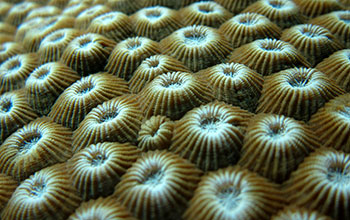Multimedia Gallery
Closeup of the polyps of the coral Diploastrea heliopora
A closeup of the polyps of the coral Diploastrea heliopora, whose dome-shaped colonies can reach sizes of up to 5 meters across.
More about this image
Coral microbiomes play an important role in coral reef health. Monica Medina, a marine biologist at The Pennsylvania State University, is funded by the National Science Foundation's (NSF) Dimensions of Biodiversity program (grant OCE 1442206) to study coral microbiomes. Understanding what lies deep within coral reefs will help to protect these imperiled ecosystems, now under siege by El Niño's unusually warm waters. Medina's research aims to describe the composition of the coral microbiome and determine its role in coral physiology and health.
NSF interviewed Medina for Earth Day 2016, along with Mike Sieracki, a program director in NSF's Division of Ocean Sciences, and Simon Malcomber, a program director in NSF's Division of Environmental Biology. Medina's research on coral microbiomes is funded by these divisions.
In the interview, when asked what a coral microbiome is, Medina explained: "The coral microbiome is all the microscopic critters living in and on the coral animal. The best-studied members of the coral microbiome are the Symbiodinium, photosynthetic algae that live within the tissues of many coral species. In this relationship, corals provide the algae with a protected environment and in return, the algae supply the coral with sugars generated through photosynthesis. However, this only scratches the surface of the coral microbiome, which contains an astonishing diversity of microorganisms. Our research aims to describe the composition of the coral microbiome and to determine its role in coral physiology and health."
Studies of the human microbiome have revealed that many bacteria help humans stay healthy. When asked if this is also true for corals, Medina explained: "Bacteria in the coral microbiome perform functions vital for coral survival. For example, some microbes help corals by fixing nitrogen, which can be a scarce resource on reefs, while others produce antibiotics that ward off potential pathogens. Without their microbiomes, corals could not persist."
When asked whether all these microbes are beneficial to corals, Medina explaned: "Through our NSF Dimensions of Biodiversity project, we're working to identify whether there is a shared microbiome across all corals. However, the microbial community in a coral reef is always in flux and is context-dependent, so if a coral is stressed, it will be more prone to harboring pathogenic microbes than healthy coral of the same species."
Medina was also asked how understanding microbiomes can help humans and corals. She responded: "Many treatments in development for diseases such as cancer are derived from the microbes associated with marine invertebrates. That underscores the importance of exploring coral microbiomes. Studying animals with primitive immune systems--but with levels of microbial complexity potentially exceeding those of humans--will enable us to discover the universal organizing principles in microbial communities."
Malcomber said this research will help to understand the relationship between microbes and reef-building corals--and how each organism is benefiting--and will provide important new information on how microbial communities help corals respond to stresses and disease.
You can read the interview in its entirety in the NSF Discovery story Earth Day: New insights into coral health hidden in reefs' microbiomes. (Date image taken: 2015-2016; date originally posted to NSF Multimedia Gallery: Nov. 14, 2016)
Credit: Ryan McMinds, Oregon State University
See other images like this on your iPhone or iPad download NSF Science Zone on the Apple App Store.
Images and other media in the National Science Foundation Multimedia Gallery are available for use in print and electronic material by NSF employees, members of the media, university staff, teachers and the general public. All media in the gallery are intended for personal, educational and nonprofit/non-commercial use only.
Images credited to the National Science Foundation, a federal agency, are in the public domain. The images were created by employees of the United States Government as part of their official duties or prepared by contractors as "works for hire" for NSF. You may freely use NSF-credited images and, at your discretion, credit NSF with a "Courtesy: National Science Foundation" notation.
Additional information about general usage can be found in Conditions.
Also Available:
Download the high-resolution JPG version of the image. (905.5 KB)
Use your mouse to right-click (Mac users may need to Ctrl-click) the link above and choose the option that will save the file or target to your computer.

 All images in this series
All images in this series